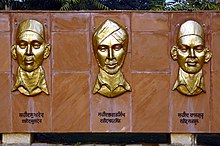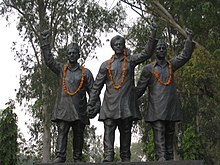Hussainiwala National Martyrs Memorial
हुसैनीवाला राष्ट्रीय शहीदी स्मारक, पंजाब, भारत | |
 National Martyrs Memorial Hussainiwala, Firozpur, Punjab | |
 | |
| 30°59′51″N 74°32′49″E / 30.99750°N 74.54694°E | |
| Location | Hussainiwala, Firozpur district, Punjab, |
|---|---|
| Designer | Government of Punjab, India |
| Type | Memorial wall and statue |
| Material | Brick, mortar, marble and metal |
| Opening date | 1968 |
| Dedicated to | Bhagat Singh, Shivaram Rajguru and Sukhdev Thapar |
| Website | www |
Hussainiwala National Martyrs Memorial (हुसैनीवाला राष्ट्रीय शहीदी स्मारक, पंजाब, भारत) in memory of the Indian freedom fighters Bhagat Singh, Sukhdev Thapar and Shivaram Rajguru, is at Hussainiwala village, near Firozpur city in Firozpur district of the Punjab, India. A daily flag lowering ceremony, similar to the Wagah-Attari border ceremony is also held here jointly by the Indian and Pakistani armed forces.
Martyrs Memorial[edit]
The memorial marks the location on the banks of the Sutlej river where Bhagat Singh, Sukhdev, and Rajguru were cremated on 23 March 1931. After they were hanged in the Lahore Central Jail, the back wall was broken by the jail authorities, and their bodies were secretly brought to this memorial and cremated without any ceremony.[1] The BSF has showcased the pistol with which Bhagat Singh killed British officer Saunders.[2] It is also the cremation place of Batukeshwar Dutt, who died in 1965 and had also been involved in bombing the Central Legislative Assembly with Singh. His last wish was to be cremated at the same place.[citation needed] The mother of Bhagat Singh, Vidyawati, was also cremated there in accordance with her last wish.[citation needed]
The memorial was built in 1968[3] and is located 1 kilometre (0.62 mi) from the border of India and Pakistan border, on the Indian side. After the Partition of India, the cremation spot became a part of Pakistan but on 17 January 1961, it was returned to India in exchange for 12 villages near the Sulemanki Headworks (Fazilka). This action of the government was due to the pressure of AISF the student organization of CPI. The activists of AISF and AIYF conducted mass gatherings and protests to return Hussainiwala.[4] The part of remains of Old railway line connecting Ferozpur with Lahore is also preserved here.[5]
Annual mela[edit]
Every year, on 23 March, the Shaheedi Mela is observed at the memorial.[6] The day is also observed across the state of Punjab.

Flag lowering ceremony[edit]
A daily ceremony is held here in the evening at Hussainiwala-Ganda Singh Wala border.[7]
See also[edit]
- Border ceremonies of India
- Borders of India
- Jallianwala Bagh
- Look-East Connectivity projects
- Look East policy (India)
References[edit]
- ^ District Administration. "The National Martyrs Memorial, Hussainiwala Border". www.ferozepur.nic.in. District Administration, Ferozpur. Retrieved 5 January 2022.
- ^ Sethi, Shiv (28 December 2019). "Hussainiwala border: Where patriotism flows". The Free Press Journal. Retrieved 5 January 2022.
- ^ "The Sunday Tribune - Spectrum". Archived from the original on 1 October 2015. Retrieved 21 October 2011. Making of a memorial by K. S. Bains
- ^ "Why Indian Sikhs need binoculars for darshan across the border". The Times of India.
- ^ Dhupad, Mohit (31 January 2018). "देखिए वो जगह, जहां साथियों की लाशें छोड़ भाग गए थे पाकिस्तानी सैनिक, मिली थी हार". Amar Ujala. Retrieved 5 January 2022.
- ^ "Dress and Ornaments". Archived from the original on 1 October 2015. Retrieved 29 April 2016.
- ^ District Firozpur website: Retreat Ceremony at Husainiwala
